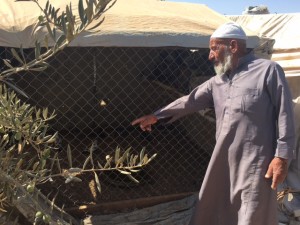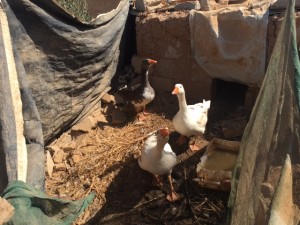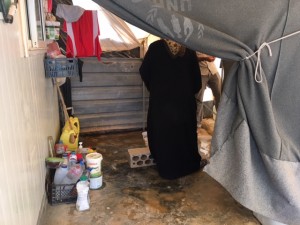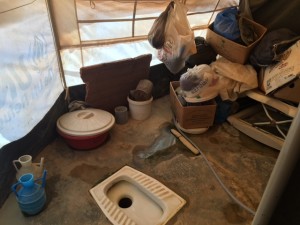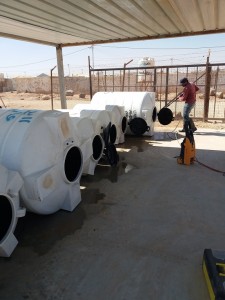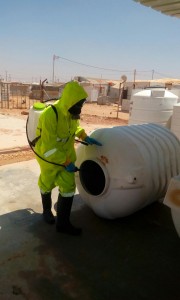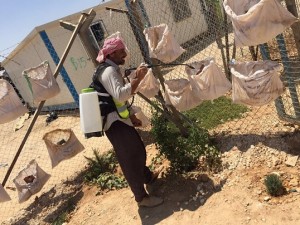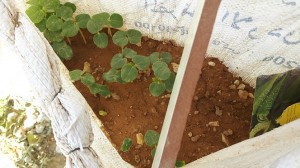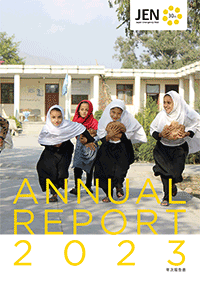Transition of Za’atari Refugee Camp
It has been more than 4 years since the Za’atari Refugee Camp was established in order to accept Syrian refugees. The camp started with 10 to 20 temporary tents for living set up in a vacant lot. Social infrastructures such as school, hospital, police station, supermarket, shopping center, amusement facilities, community center, water and sewage facilities have been constructed since then. The refugee camp has been transformed into a small city where approximately 80 thousand people are living. Given this number of inhabitants, it is easy to imagine each refugee and each family have various life styles.
On the one hand, there are families consisting of 3 to 4 household members that get together to help each other. On the other hand, there are fatherless families with small children who are living quietly in an uncomfortable environment where neighbors are talking about their family situation.
The man in the photo lives with his son’s family which consists of 3 household members. Four temporary houses adjoin each other on the premises and there is a large courtyard. In the courtyard, he raises more than one kind of crops and has ducks and chickens.
[The man in the garden]
[The birds in the garden]
This lady has a son who is mentally unstable. Since he works at a tomato farm outside of the Camp, she spends almost all of her time alone at home, both in daytime and at night. Also, it is very hard for her to use a toilet because she has difficulty with her legs.
[The lady in the Camp]
[The house’s toilet]
The time to provide minimum necessary emergency support for living to improve the lives of the Syrian refugees has gone. It is now vital to consider further support.
Each person or each family has different situation, e.g. having physical or mental difficulties, young and elderly without kith or kin, single mother as head of the family, and those needing nursing care.
Improvement of the quality of life for those who are in such status needs serious consideration. In addition to tackling these issues, we will cooperate not only with international (humanitarian) organization, but also with the local government and local companies to construct better social infrastructure for better lives and communities. Now is the right time to do this at Za’atari Refugee Camp.
【JEN is now accepting donations. Your help would be very much appreciated.
DONATE here】
[The Media Project]No.12 Birds of Paradise
Results of the monitoring of water tank disinfection
I am Shaher Al-Lahem. I have been working for JEN as an engineer since December 2013.
Since February 2015, as a member in charge of monitoring and evaluation, I have been surveying the effect and efficiency of JEN activities, projects, and programs. Today, I would like to share one of JEN’s important activities.
[Disinfection of water tank]
The purpose of this activity is to keep water, which the refugees drink, safe and clean.
Trucks carrying water run all around the refugee camps and fill the tanks with water every day. Owing to hot weather and dust in air, there is a possibility of spreading of bacteria everywhere in the tank and change in water quality, thereby causing bacterial outbreak or increase in deposit and algae.
In the past, JEN used to disinfected public water tanks of the 3rd, 4th, 5th section at least twice a year as a folk group supporting water–hygiene activity. Later on, as more and more people came to have their own tank, JEN also began to disinfect private water tanks. The total number of water tanks disinfected in these 3 sections has amounted to 1,000.
The maintenance team collects water tanks from people and disinfects them. First, tanks are washed with soap and water, then disinfected with chlorine, and finally rinsed. JEN works carefully not to leave chlorine of more than 1.8ppm.
[Disinfecting water tanks]
There used to be a problem with people not leaving their tanks to us with the fear of the tanks not being returned to them or being exchanged to old ones.
In order to solve such problem, efforts were made to disseminate the right information to people as well as the merits and importance of tank disinfection.
Originally as we had built up relationship of mutual trust between people of 3rd-5th section, we succeeded in persuading all of them. And this time we could return water tanks to everyone at the end of working day as well.
This time, I am in charge of surveying the chlorine rate left in the tank after disinfection. I aim to obtain a numerical value as exactly as possible and let people know the water in the tank is safe to drink. Moreover, we can have a strong motivation every time we obtain a good result.
I believe that monitoring an index and evaluating result of work is indispensable in providing a supporting hand to the refugees properly.
Shaher Al-Lahem
【JEN is now accepting donations. Your help would be very much appreciated.
DONATE here】
[The Media Project] No.11 Videos produced in Za’atari refugee camp by Syrian youths
Searching for the feasibility of vertical gardens
Many residents in Za’atari Refugee Camp used to be farmers when they were in Syria. In fact, many of them started building kitchen gardens as emotional mainstay, by making use of small spaces. They presently grow vegetables, fruits and flowers in the gardens.
However, there is one major problem. Given the temperature of higher than 40 degree Celsius in Jordan during summer, saving water is crucial. Therefore, JEN tried to find a way to continue kitchen gardens while saving water and prototyped a vertical garden with the use of simple bags and walls.
Currently, JEN, together with the residents, grows plants while monitoring regularly the water consumption, development speed of seeds and seedlings, and other important matters for maintenance.
[Watering to a vertical garden]
[The growth of Zucchini]
【JEN is now accepting donations. Your help would be very much appreciated.
DONATE here】

![Jordan [Syrian refugees]](/en/project/images/mainimg_project_jordan.jpg)
